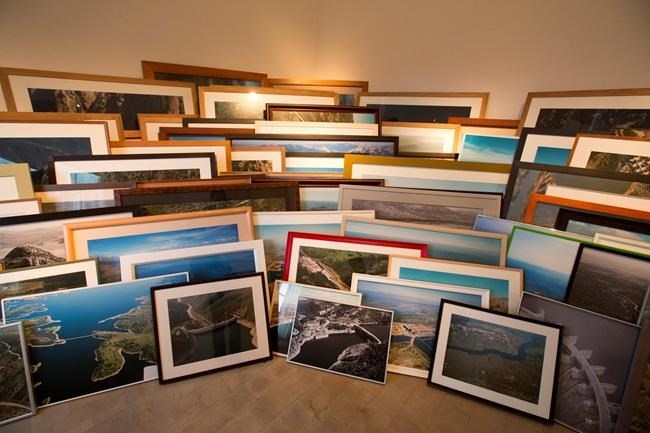
CORRECTS FIRST NAME OF ARTIST TO IBON - This Tuesday, Oct. 10, 2017 photo shows an art installation created by Spanish artist Ibon Aranberri as part of the South American biennale or Bienalsur, at the Museum of Immigrants, in Buenos Aires, Argentina. The contemporary art fair goes beyond a fixed geographic location. 379 artworks are being exhibited simultaneously from September to December in museums, cultural centers and public spaces in more than 30 cities and 16 countries worldwide. (AP Photo/Victor R. Caivano)
October 13, 2017 - 1:50 PM
BUENOS AIRES, Argentina - The impeccably white Palais de Glace in Argentina's capital is a national historic monument that once housed the country's fine art museum. But these days it looks like a giant candy cane.
The building's walls were painted in brightly colored stripes and wrapped in neon lights by French artist Bertrand Ivanoff as part of the recent opening of the South American biennale, Bienalsur. The contemporary art fair seeks to draw in new audiences by giving artists free range to experiment and showcase works that break the mould.
Established biennales like Venice are run by one curator who chooses a common theme. At Bienalsur, the themes are wide ranging — from humanity's relation with nature to borders and immigration. And the fair extends beyond one geographic location. Buenos Aires is the biennale's ground zero but 379 artworks are being exhibited from September to December in museums, cultural centres and public spaces in more than 30 cities and 16 countries.
"Today's art is a prisoner of big players - a group of 20 galleries and 20 curators who decide," said Marlise Ilhesca, Bienalsur's international adviser. "This is the first time that artists are free to propose themes, situations and spaces."
One of Bienalsur's themes is the link between art and social action.
Iranian photographer Reza Deghati, whose images have appeared on the cover of National Geographic, taught a three-month workshop to children in one of Buenos Aires' most dangerous slums. His students captured images of their daily lives that are now on display in a major public square.
"One photograph won't change the world," Deghati said. "But it will change one person who will change the world."
Deghati said he hopes the workshop helps other residents of Buenos Aires learn about the realities of children living in slums and foster inclusion.
"You fear what you don't know," he said. "That's what creates isolation."
The collaborative "Turn" project by Japanese artist Katsuhiko Hibino includes artworks by children with autism, young drug addicts and kids from a poor area of Peru's capital.
"Art on the Borders" displays works in areas that are disputed by neighbouring countries, such as Chile and Peru or Colombia and Venezuela.
Focusing on the concept of time, Argentine artist Marie Orensanz nailed 12 watch needles of different sizes at a Buenos Aires park; Brazil's Regina Silveira painted large black hands on a building inside Memory Park, which is dedicated to people who were forcibly disappeared during Argentina's 1976-1983 dictatorship; and Portugal's Pedro Cabrita Reis installed a huge neon beam on the steps of the neoclassical building that houses the law faculty of Buenos Aires University.
Bienalsur also rebelled against the "don't touch the art" concept of museums and exhibits. "Take me, I'm yours" by France's Christian Boltanski and Germany's Hans Ulrich Olbrist, exhibits things from daily life that visitors to the Buenos Aires Museum of Decorative Art can not only touch, but take home.
Brazilian artist Eduardo Srur wants to raise awareness about pollution by placing two giant floating bottles on the Riachuelo, a river in Argentina's capital that is so polluted it was once named one of the world's 10 dirtiest places.
Ilhesca describe the biennale as an exercise in changing the rules of art.
"When artists step out of the pigeonholes of the market, or the elite of curators, they can surprise the world," she said.
News from © The Associated Press, 2017